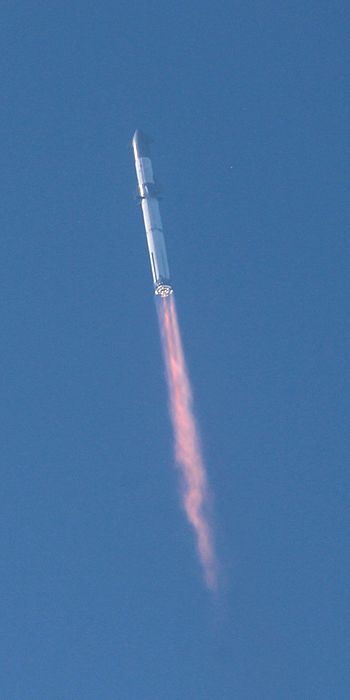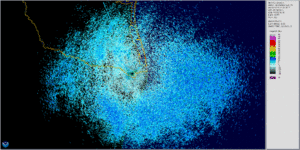SpaceX Starship orbital test flight facts for kids

Fully stacked Starship vehicle during its first flight
|
|
| Mission type | Flight test |
|---|---|
| Operator | SpaceX |
| Mission duration | 3 minutes, 59 seconds (achieved) 90–100 minutes (planned) |
| Orbits completed | 0 (achieved) <1 (intended) |
| Start of mission | |
| Launch date | April 20, 2023 08:33 CT |
| Rocket | Starship |
| Launch site | Starbase, Texas |
| Contractor | SpaceX |
| End of mission | |
| Destroyed | April 20, 2023 |
| Orbital parameters | |
| Regime | Transatmospheric Earth orbit (intended) |
| Periapsis | 50 km (31 mi) (planned) |
| Apoapsis | 250 km (160 mi) (planned) |
The Starship Flight Test was a big step for SpaceX. It was the first time their huge Starship spacecraft flew together with its powerful Super Heavy rocket booster. Before this, only the top part of Starship had flown in tests, practicing how to fly and land. This launch made Starship the tallest and strongest rocket ever to fly! It had twice the power of the famous Saturn V rocket.
The plan was for Starship to go into a special orbit around Earth, almost completing one full circle. It would fly over the Strait of Florida before coming back down near Hawaii. The Super Heavy booster was supposed to land gently in the Gulf of Mexico.
The test launched from SpaceX's Starbase site in Boca Chica, Texas. On April 20, 2023, at 8:33 a.m. CT, the rocket lifted off. However, three of its 33 Raptor engines stopped working right at the start. Three more engines failed during the flight, making a total of six lost engines. Even with these engine problems, the rocket got past the critical point called max-q, which is when the rocket feels the most stress from the air.
But when the two parts of the rocket tried to separate, Starship started spinning out of control. Safety teams then used the flight termination system to end the flight. The rocket broke apart at 8:37 a.m. CT over the Gulf of Mexico.
Contents
What is Starship?
Starship is a giant rocket system built by SpaceX. It is designed to be the largest and most powerful rocket ever. It stands 120 meters (394 feet) tall. Starship can carry a huge amount of cargo, about 150,000 kilograms (330,000 pounds).
The Super Heavy first stage, which is the bottom part, is the most powerful rocket stage ever launched. Its 33 Raptor engines create more than 16 million pounds of thrust. This is about twice the power of the Saturn V rocket. It's also much more powerful than the SLS rocket, which launched in 2022.
SpaceX wants both parts of Starship to land back at the launch site. This way, they can be used again and again. SpaceX plans to use Starship for many things. These include putting satellites into space, taking people on space trips, and even traveling to other planets.
How Starship Was Developed
SpaceX started building test versions of the upper part of Starship in 2019. They launched these prototypes nine times. On May 5, 2021, Starship SN15 made a successful soft landing after a 6-minute flight.
After this, SpaceX kept building new versions of Starship. They also built several Super Heavy boosters. They did many ground tests but no more flights for a while. This was because they were waiting for permission from the government to launch.
In June 2022, a review of the launch site was finished. It said that SpaceX could launch, but they had to protect local wildlife and historical places. The Federal Aviation Administration (FAA) gave SpaceX the license to launch on April 14, 2023.
The Flight Plan
The plan for this test flight was for Starship to fly into a special orbit. This orbit would be about 250 kilometers (155 miles) high at its highest point and 50 kilometers (31 miles) at its lowest. Starship would then come back into Earth's atmosphere after about 1 hour and 17 minutes. It would almost complete one full orbit.
Even though Starship is designed to be reusable, this test flight did not plan for the rocket parts to land gently. Instead, both the booster and the spacecraft were meant to fall into the ocean. The Super Heavy booster was planned to land about 20 miles offshore in the Gulf of Mexico. The Starship spacecraft was planned to land in the Pacific Ocean, about 100 kilometers (62 miles) northwest of Kauai.
| Time | Event | April 17 | April 20 |
|---|---|---|---|
| −02:00:00 | SpaceX Flight Director checks if everything is ready for fuel loading | Success | Success |
| −01:39:00 | Super Heavy booster starts loading fuel (liquid oxygen and liquid methane) | Success | Success |
| −01:22:00 | Starship starts loading fuel (liquid methane) | Success | Success |
| −01:17:00 | Starship starts loading oxidizer (liquid oxygen) | Success | Success |
| −00:16:40 | Booster engines get ready | Success | Success |
| −00:00:40 | Fuel lines start venting | Not passed | Resumed after hold |
| −00:00:08 | Booster engine starting sequence begins | N/A | Success |
| −00:00:06 | First stage engines ignite | N/A | Success |
| 00:00:00 | Liftoff | N/A | Success |
| 00:00:55 | Max Q (when the rocket feels the most pressure from the air) | N/A | Success |
| 00:02:49 | Main engine cutoff (MECO) | N/A | ? |
| 00:02:52 | Rocket parts separate | N/A | Failure |
| 00:02:57 | Starship engines ignite | N/A | N/A |
| 00:03:11 | Booster starts its boostback burn | N/A | N/A |
| 00:04:06 | Booster boostback burn ends | N/A | N/A |
| 00:07:32 | Booster goes through the speed of sound | N/A | N/A |
| 00:07:40 | Booster starts its landing burn | N/A | N/A |
| 00:08:03 | Booster splashes down | N/A | N/A |
| 00:09:20 | Starship engine cutoff (SECO) | N/A | N/A |
| 01:17:21 | Starship starts re-entering the atmosphere | N/A | N/A |
| 01:28:43 | Starship goes through the speed of sound | N/A | N/A |
| 01:30:00 | Starship splashes down in the Pacific | N/A | N/A |
First Launch Attempt (April 17)
The first try to launch Starship was on April 17. The rocket was filled with fuel and ready to go at 1:20 p.m. UTC (8:20 a.m. CT). But the launch was stopped because a valve on the Super Heavy booster froze. This valve helps control the pressure inside the booster.
SpaceX tried to fix the problem and launch that same day. But the valve wasn't responding well. So, mission control decided to stop the countdown at T-40 seconds. They wanted to use the fuel and pressure they had for a practice run instead of risking the whole rocket. SpaceX said it would take at least 48 hours to refuel for another try.
The Launch on April 20

The second chance to launch was on Thursday, April 20. A 92-minute launch window opened at 1:28 p.m. UTC (8:28 a.m. CDT).
The rocket lifted off from Starbase, in Boca Chica, Texas. At 8:33 a.m. CDT, the launch was successful, and the rocket cleared the launch tower. But as it lifted off, three of its 33 Raptor engines stopped working. By 1 minute and 7 seconds into the flight, six Raptor engines had shut down.
The rocket successfully passed max q, the point of highest stress. However, the booster and spacecraft did not separate as planned at 2 minutes and 52 seconds into the flight. The rocket appeared to start flipping without its engines shutting down first.
During this failed separation, the Starship and Super Heavy booster stayed attached. The rocket began spinning out of control and white smoke came out. The two parts stayed together for over a minute. Then, the rocket's flight termination system was activated. This caused the vehicle to break apart on purpose for safety. The Booster 7 was destroyed at 3 minutes and 59 seconds into the flight. Ship 24 exploded at 4 minutes and 1 second. The rocket reached a highest point of 39 kilometers (24 miles).
Because SpaceX did not use much protection for the launch pad, the rocket caused some damage. When it lifted off, huge clouds of sand and dust were kicked up. People in Port Isabel, Texas, about 10 miles away, reported that their cars and other surfaces were covered in particles. A window at a local business also shattered. The concrete under the rocket and launch pad was also badly damaged.
What People Said
- Bill Nelson, who leads NASA, and Josef Aschbacher, who leads ESA, both congratulated SpaceX. Nelson said that big achievements always involve some risk, and that great rewards come from great risks. He looked forward to what SpaceX would learn from this flight.
- SpaceX said on Twitter that "today's test will help us improve Starship's reliability." They want to make Starship reliable enough to help humans live on other planets. Elon Musk, the head of SpaceX, said they would try to test the rocket again in a few months.
- The Federal Aviation Administration (FAA) said it would investigate the flight. This is normal when a rocket is lost during a flight. There were no reports of injuries or damage to property from the rocket breaking apart.
- Jordan Brimm, a space historian from the University of Chicago, said the launch was a big step forward. He called it "significant progress" toward a reusable super-heavy rocket.
- Loren Grush, a space reporter for Bloomberg News, said the explosion showed the challenges ahead for Musk's big plans. She noted that SpaceX still needs to work on Starship's life support systems and how to refuel it in space. Grush also called the booster's first takeoff a "win." She added that the first launches of new commercial rockets are rarely fully successful.

